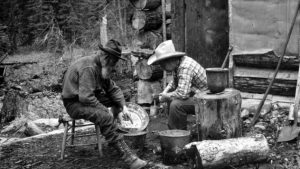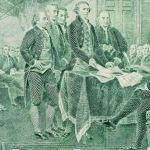 Technology
Technology  Technology
Technology  Our World
Our World 10 Ways Icelandic Culture Makes Other Countries Look Boring
 Misconceptions
Misconceptions 10 Common Misconceptions About the Victorian Era
 Mysteries
Mysteries 10 Strange Unexplained Mysteries of 2025
 Miscellaneous
Miscellaneous 10 of History’s Most Bell-Ringing Finishing Moves
 History
History 10 Great Escapes That Ended Right Back in Captivity
 Weird Stuff
Weird Stuff 10 Fascinating Things You Might Not Know About Spiders
 Food
Food 10 Everyday Foods You Didn’t Know Were Invented by the U.S. Military
 History
History 10 Odd Things Colonial Americans Kept at Home
 Weird Stuff
Weird Stuff 10 Superstitious Beliefs That Once Consumed Entire Cultures
 Technology
Technology 10 Scientific Breakthroughs of 2025 That’ll Change Everything
 Our World
Our World 10 Ways Icelandic Culture Makes Other Countries Look Boring
 Misconceptions
Misconceptions 10 Common Misconceptions About the Victorian Era
Who's Behind Listverse?

Jamie Frater
Head Editor
Jamie founded Listverse due to an insatiable desire to share fascinating, obscure, and bizarre facts. He has been a guest speaker on numerous national radio and television stations and is a five time published author.
More About Us Mysteries
Mysteries 10 Strange Unexplained Mysteries of 2025
 Miscellaneous
Miscellaneous 10 of History’s Most Bell-Ringing Finishing Moves
 History
History 10 Great Escapes That Ended Right Back in Captivity
 Weird Stuff
Weird Stuff 10 Fascinating Things You Might Not Know About Spiders
 Food
Food 10 Everyday Foods You Didn’t Know Were Invented by the U.S. Military
 History
History 10 Odd Things Colonial Americans Kept at Home
 Weird Stuff
Weird Stuff 10 Superstitious Beliefs That Once Consumed Entire Cultures
10 Cool Gold Rushes They Don’t Teach in History Class
There’s no question that you were taught about gold rushes as a kid in history class. The great California Gold Rush of 1849 is probably the one you are most familiar with. That’s the case for most people, at least. Other gold rushes in the western part of the United States were also notable: the Black Hills Gold Rush in South Dakota, the Comstock Lode in Nevada, the Pikes Peak Gold Rush in Colorado, and the Klondike Gold Rush in Alaska. To hear the most basic high school-quality history books tell it, you’d think that the only gold rushes that ever occurred were in the Intermountain West!
But that’s not the case. In reality, gold rushes have happened all over the world—and at plenty of different times throughout history. And in this list, that’s exactly what we will focus on: all the other gold rushes that (mostly) escape the history books. These are the fascinating and true tales of ten gold rushes that the world has mostly forgotten about. Brush up on these interesting stories as you dream about what you’d do with the fortune some of these men attained!
Related: 10 Glittering Golden Artifacts from the Ancient World
10 Cabarrus County, North Carolina (1803)
In 1799, a 12-year-old boy named Conrad Reed was digging around on his family’s farm in Cabarrus County, North Carolina, north of Charlotte. Amazingly, he uncovered a massive gold nugget while doing his digging. The family was impressed—but not THAT impressed. That’s because they used the big, shiny rock as a doorstop for the next several years! But one day in 1803, Conrad’s dad, John Reed, decided to take the nugget to a local jeweler. The man loved what he was and offered $3.50 (about $70 today) for it. John took the deal and walked out of the store with some cash in his pocket.
Weeks later, though, it began to dawn on John just what his son had found. So, later that year, he and a few other local farmers formed a partnership in which they went out looking more purposely for gold on their properties. They immediately found a whopping 28-pound (12.7-kilogram) golden nugget elsewhere on the farm. And more just kept coming! Soon, local newspapers began reporting the findings. And soon after that, other men began to descend on the area seeking their own riches. Over the next few years, farmers from all over the region would wrap their growing seasons in the fall and dig out shallow surface mines every winter.
By around 1820, those shallow pits had been mined of all the available gold. So, through the 1820s, the same North Carolina farmers hired experienced miners from places as far away as Cornwall, England, to dig much deeper mine shafts. For the next two decades, those deep and complicated shafts produced tons more gold, silver, and quartz.
By the mid-1840s, though, the minerals had all been pulled up from the ground, and the decades-long mining boom was pretty much bust. Still, it was a heck of a run for North Carolina. And it’s one they still honor today! The mascot of the local college, the University of North Carolina at Charlotte, is the 49er—an homage to the region’s mining history.[1]
9 Habersham County, Georgia (1829)
While North Carolina’s 1803 gold rush might have been the first major mining operation in the then-young United States, Georgia’s 1829 gold grab was the first to get truly national media attention. Locals in the northeastern corner of Georgia, then known as Habersham County (and today called White County), found gold in the area at some point in the mid-1820s. Nobody alive today knows who saw it first, when they found it, or where the first strike occurred. But word started to get out that gold was there by the very end of 1828. And early the next year, all hell broke loose when miners from all over descended to get rich quick.
Thousands of men showed up in Habersham County to mine shallow pits and pan rivers for gold. Some were equipped for and experienced at the work—but the vast majority were not. Immediately, the large population influx upset the local Cherokee people living on the land for ages. Before long, there was simply too much tension between the indigenous Cherokee groups who called the area home and the newly settled immigrants who were trying to dig their fortunes out from the ground. Something had to give. And in 1830, President Andrew Jackson was the one to tip the scales.
On May 28 of that year, Jackson signed the now-infamous Indian Removal Act. With one quick stroke of the pen, to grant the northeastern region of Georgia fully to miners and prospectors, he ceded those native lands to American citizens. In turn, he ordered the Cherokee and their neighbors to be removed from their homelands. The awful journey the tribes went on would come to be known as the Trail of Tears. It was then (and remains today) one of the lowest and most awful points in American history. And it all started because of a gold rush…[2]
8 Gold Coast, Ghana (1471)
One of the most intense (and tragic) gold rushes that ever occurred began in 1471. That year, Portuguese sailors and explorers landed on the coast of West Africa. They made land in what is now known as present-day Ghana. Almost immediately, they discovered massive gold deposits along the river called Pa. Over the next couple of decades, throngs of Europeans flocked down to Ghana. They endlessly mined the river for gold until the deposits were hollowed out. They also built castles and military fortifications up and down the river and along the ocean. In turn, they gave the area the nickname that is still in use today: the Gold Coast.
Sadly, gold mining was the least invasive aspect of this years-long assault on the land. The Portuguese and their European counterparts weren’t exactly kind to the African natives who had lived there for centuries. Violence was commonplace, and so was slavery. As the Portuguese influence waned after about a century, the Dutch took over with an even more brutal campaign to enslave and subjugate the locals to do their colonial bidding. In time, a budding slave trade developed.
That portion of this story is taught often (or at least, it should be taught often) in American schools: the transatlantic slave trade, the middle passage, and the plantations and farms in the new world that housed these enslaved peoples. Countless Africans were shipped against the Atlantic Ocean across their will to the Caribbean, Brazil, and the nation that would soon become the United States. But when you go back to the very beginning, it all started because of a gold rush. Had the Portuguese not found so much gold along the River Pa, would things have been the same? We don’t know. But it certainly changed the world for centuries after.[3]
7 Fraser River, British Columbia (1858)
By the 1850s, roughly 50,000 indigenous people lived in British Columbia’s Fraser River region. Then, one day in 1856, a man from the Shuswap indigenous nation went on a fishing expedition and found gold in the area’s Thompson River. The locals managed to keep it a secret for nearly two full years. They had heard about the gold rushes going on in places like California, and they didn’t want thousands of white settlers to descend on their area and ruin the land. So, for a while, the silence worked. But then, in 1857, somebody found another deposit of gold in the area—and they sent a sample down to San Francisco for testing.
Word got out as soon as that happened, and the test confirmed the rich and bountiful presence of gold in the rocks. And by the middle of 1858, the rush was on. Sadly, it forever changed the region for the Shuswap people. In just a few months, the population of the region nearly doubled. Roughly 50,000 white people showed up and swept into the Fraser Canyon area. Many had come from the now-depleted California gold fields and were dead-set on making their fortune no matter what. Because of that, they were frustrated by their lack of success in California and aggressively intent on mining absolutely every last square foot of the Fraser River. It turned out to be an awful combination.
Migrant miners quickly overwhelmed the local indigenous villages and settlements. And by the summer of 1858, the war had already begun to brew. That July, the ill-fated Fraser Canyon War broke out. Natives fought to protect their ancient homelands; invading whites fought for access to the gold fields. In the end, neither side really won. But the miners did manage to get what they came for (the gold) before sweeping out of the area and leaving it a desolate, ruined shell of what it once had been. Then, by the early 1860s, it was truly over for the locals: Canada annexed the region and called the new province British Columbia. And thus, a gold rush ushered in the end of a way of life forever.[4]
6 Witwatersrand, South Africa (1884)
In 1884, multiple men discovered small deposits of gold in various places near the city of Johannesburg, South Africa. By that time in the very late 19th century, it was already evident to miners and fortune seekers all over the world what those discoveries meant. And locals also knew what was to come. But amazingly, it took two full years for the discoveries to be realized and preyed upon by the masses. That’s because it wasn’t until June 1886 when a local farmer named George Harrison found a large gold deposit on the Langlaagte Farm. Considering the size of that find, it was only a matter of days before the whole area blew up with activity.
In just a month, more than 3,000 gold seekers rushed into the area around Johannesburg. Thus began the official South African Gold Rush—a critical but often overlooked rush on the pricey mineral. Many people tried to pan for gold in rivers throughout the region for a while. However, it only took a few short weeks for the large-scale mining companies to take over. The Witwatersrand Gold Mining Company was established by late September of that year. They set up shop, leased out massive areas for mining rights, and started to dominate the gold search in the region. Other companies quickly followed suit.
By that time in history, the big mining companies were so efficient (and aggressive) in their work that it didn’t take long for them to mine up almost every last fleck of gold in the area. They quickly pushed out the small-time miners and did things on a large scale. After a few months, they found that the gold fields were drying up—but not before they’d made massive fortunes on digging the shiny stuff out of the ground, of course. As soon as they showed up, the big mining companies were seemingly gone. But Johannesburg went from being a sleepy town to a bustling metropolis during that time. And forever after, it has stayed on as one of South Africa’s major population centers and key urban districts.[5]
5 Siberia (1838)
To this day, Russia remains one of the most mineral-rich places on earth. And way out in Siberia, in particular, sits an incredible region of economic activity related to mining. Oil, gas, copper, iron ore, and many other minerals have been mined in the Ural Mountains and far beyond. But just like many places on Earth, a gold rush was what really solidified the far wilds or eastern Russia as a place for miners. This gold grab started way back in 1838. And while the gold rush there was as economically plentiful as any across the globe, the circumstances under which it began were very different. Because of that, it remains one of the lesser-known gold rushes of all time.
Locals living within the Yenisey River basin were the first to find gold early in 1838. When word got out, Russian government leaders immediately sent in loyalists to take control of the mining operations. Thus, instead of intrepid explorers and free men pushing for gold—like all the rushes simultaneously occurring in America and elsewhere—this Siberian gold push was run by the use of forced labor. Russian leaders brought in migrant workers from all over the region, and even as far away as northern China, to mine the river’s banks. They kept them there under the threat of violence should they try to escape. And the leaders made sure they were very, very productive.
Inevitably, the Chinese slave laborers wore down, got sick, and died off. So, the Russian government turned to their own people for more forced labor. They imprisoned local peasants, drifters, and thousands of people who lived among the landless poor. Then, they forced them all to head to the gold fields and mine. As you might expect, the conditions there were absolutely abysmal. And yet, the labor inevitably produced tons of value for the wealthiest Russians, too. Thus came and went one of the least-known gold rushes ever…[6]
4 Tierra Del Fuego, Argentina (1883)

The most bizarre gold rush in history never would have happened had it not been for a shipwreck. In 1883, a French steamship called the Arctique ran aground on the rocky and unpredictable coastline of Argentina’s Tierra Del Fuego. And since the accident happened on the southernmost tip of South America, the ship’s sailors were immediately in grave danger. The weather was awful, the seas were rough, the winds were unbearable, and it was only a matter of time before everybody involved would surely perish. So, a rescue expedition rushed over to save the crew. And while the rescuers were busy freeing the Arctique from its place stuck aground on the spit of land, they noticed something flashing in the dark soil: gold flecks!
It didn’t take long for word of that unexpected discovery to sweep across Europe. And suddenly, prospectors and mining hopefuls from around the world were rushing down to one of the most remote regions on earth. Over the next three years, Tierra Del Fuego proved to be one of the most productive gold rushes anywhere. More than 5,000 pounds (2,268 kg) of the stuff was mined from the lands around there. But it didn’t come out without a price. The awful weather and rugged terrain made mining in the region extremely dangerous. Many men died during their quest for fortune; many more were made unbelievably rich.
In the end, the gold fields proved to be very productive for about three years. But by the very end of 1885, the mines were starting to dry up. And so, the prospectors pretty much left just as quickly as they’d arrived. A couple stayed behind to try to wring out some more dollars from the earth. Amazingly, some very small panning operations lasted well into the early 20th century. But by the 1910s, pretty much every last prospector had departed from Tierra Del Fuego for good. And so ended one of the most aggressive—and most unlikely—gold rushes of all time.[7]
3 Bathurst, New South Wales (1851)
The Australian Gold Rush of 1851 in Bathurst, New South Wales, was remarkably similar to the rush in California two years prior. Locals around Bathurst began finding tiny pieces of gold in a river there in February of that year. Amazed at the discovery and aware of what had happened in California in 1849, they started to mine. Soon enough, miners came in from all over Australia—and in short order, from all over the rest of the world, too. Some showed up from as far away as Germany and England. Others arrived fresh from their exploits in the goldfields of California. And they all wanted a shot at big riches Down Under.
Over the rest of 1851 and a few years beyond, more than half a million miners showed up to exploit Bathurst’s natural resources. So many people showed up, and they were so aggressive and pushy in trying to get rich quick that the locals came to look upon them derisively. Known by the New South Wales residents as “diggers,” the miners were seen as an annoying nuisance at best and a threat to the local way of life at worst. Like with many other gold rushes we’ve learned about thus far in this list, the contentious relationship between local landowners and residents and these immigrants was pretty tough to stomach after a while.
Unfortunately for the miners (and maybe fortunately for the locals), there just wasn’t as much gold to mine in Bathurst as in many other places. Before too long, most of the miners who had come Down Under to get rich departed without ever making anything close to a fortune. A few miners settled down in the area and stuck around for the long haul. They dropped the mining work and stayed in NSW, eventually raising families and acclimating into Aussie culture. Today, many of the descendants of those miners remain in the region. And over time, the gold rush has even become a point of pride for Australia’s national identity. Time really does heal all wounds![8]
2 Bulolo, Papua New Guinea (1922)
Just one year after the aforementioned Australian gold rush in Bathurst, another deposit of gold was discovered in the land that would come to be known as Papua New Guinea. Well, we should say that the 1852 discovery in a place called Bulolo was made by white men. That’s an important distinction; for centuries, Papuan locals had been crafting pots with flecks of gold in the clay. But it was only in 1852 that white men finally reached the highlands of the region and discovered “gold in them there hills,” as the saying goes. (But, like, literally…)
And yet, even after that, it took white explorers and later settlers almost exactly 70 years to make inroads into the uncharted territory to the point where they could begin to mine the gold. It happened not long after World War I when Australia was granted possession over what had formerly been Germany’s hold on New Guinea. Suddenly, a new Australian colony, Aussies from south of Papua New Guinea, showed up to begin prospecting. By 1922, the Australian government had fully legalized prospecting in their brand-new colonial territory of New Guinea. And by the end of that year, the rush was on.
Well-connected Australian mining magnate Cecil John Levien was the first man to buy miner’s rights around the town of Bulolo. He used old German cartographic documents to push up the mysterious Bulolo River. Eventually, he found the gold fields buried deep within the nearby highlands. Quickly, he partnered with a few other professional prospectors and started to mine for a fortune in the area. Over the next few decades, Bulolo’s gold mines produced a steady and reliable fortune for the few men sitting at the top of that economic pyramid. The Australian government was all too happy to oversee that long-term and very remote gold rush right up until Papua New Guinea achieved its independence in 1975.[9]
1 Modern Gold Rush, California
Certainly, the California gold rush of 1849 isn’t a lesser-known rush. And so, you won’t find it on this list—short of a few brief mentions above as it relates to other historic gold grabs. But did you know there’s a much lesser-known modern-day California gold rush? Yes, even here in the 21st century, some Californians still flock to the hills to mine for gold. They aren’t professional prospectors, though. And they aren’t getting rich quite like the long-ago gold titans were in the middle of the 19th century. But they are undertaking small-time panning operations in the mountain streams and rural rocky outcroppings all throughout the northern part of the Golden State. And in turn, many of them are even making a few bucks at this interesting little side hustle! Sometimes, even more than a few bucks!
There are still gold flecks that stream down through mountain ravines even today. Granted, the amount of gold we are talking about here is comparatively nothing relative to the wild mineral rights grab that occurred nearly 200 years ago. But if you’re shrewd about where to search and efficient in your ability to pan for the flecks, well, a payday can still come your way! And with the price of gold nowadays, maybe these modern-day miners and riverbed panners are onto something. Or maybe they’re just crazy.
Maybe you won’t buy a mansion using the gold you come away with in these Golden State streams. And sure, there are myriad legal issues regarding whether you can mine on public land or someone else’s super-rural private acreage unless you personally own it. But that hasn’t stopped modern amateur prospectors from trying their hand at it! So, we’ll leave you with a question to consider: Would you ever join them?[10]








